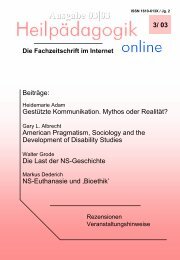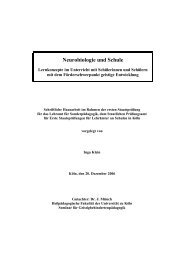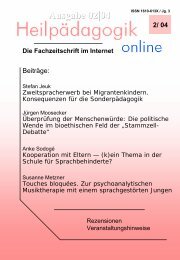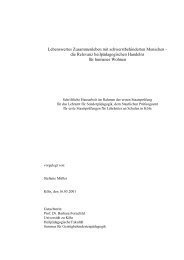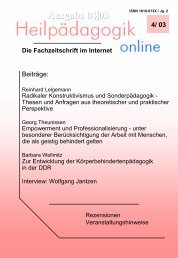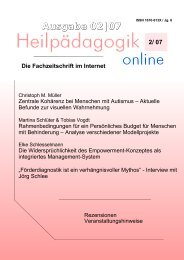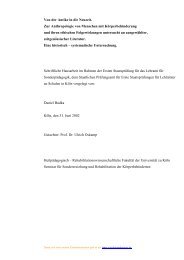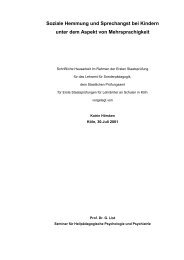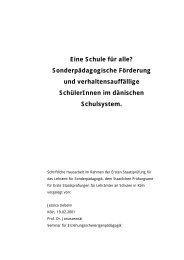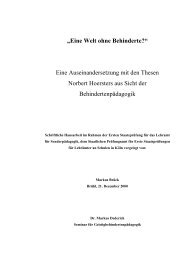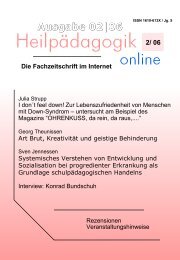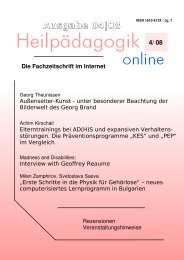Hochbegabung und Sonderpädagogik - sonderpaedagoge.de!
Hochbegabung und Sonderpädagogik - sonderpaedagoge.de!
Hochbegabung und Sonderpädagogik - sonderpaedagoge.de!
Erfolgreiche ePaper selbst erstellen
Machen Sie aus Ihren PDF Publikationen ein blätterbares Flipbook mit unserer einzigartigen Google optimierten e-Paper Software.
I<strong>de</strong>ntifikation von Hochbegabten<br />
REIS, S. M., MCGUIRE, J. M. & NEU, T. W. (2000). Compensation<br />
strategies used by high-abilitiy stu<strong>de</strong>nts with learning disabilities<br />
who succeed in college. Gifted Child Quaterly, 44(2), 123-<br />
134.<br />
RENZULLI, J. S. (1977). The enrichment triad mo<strong>de</strong>l: A plan for<br />
<strong>de</strong>veloping <strong>de</strong>fensible programs for the gifted and talented: II.<br />
Gifted Child Quarterly, 21, 227-233.<br />
RENZULLI, J. S. (1984). The Triad/Revolving Door system: A research-based<br />
approach to i<strong>de</strong>ntification and programming for<br />
the gifted and talented. Gifted Child Quarterly, 28, 163-171.<br />
SOVIK, N. (1993). Development of children's writing performance:<br />
Some educational implications. In A. F. KALVERBOER &<br />
HOPKINS, B. (Eds.), Motor <strong>de</strong>velopment in early and later<br />
childhood: Longitudinal approaches (229-246). New York:<br />
Cambridge University Press.<br />
STÖGER, H. & ZIEGLER, A. (2005). Un<strong>de</strong>rachievement <strong>und</strong> Prüfungsangst:<br />
Forschungsbef<strong>und</strong>e <strong>und</strong> Interventionsmöglichkeiten<br />
bei hochbegabten Schülerinnen <strong>und</strong> Schülern. Journal für<br />
Begabtenför<strong>de</strong>rung, 5, 7-19.<br />
STÖGER, H., ZIEGLER, A. & MARTZOG, P. (2008). Deficits in fine<br />
motor skill as an important factor in the i<strong>de</strong>ntification of gifted<br />
<strong>und</strong>erachievers in primary school. Psychology Science<br />
Quarterly, 50, 134-147.<br />
TERMAN, L. M. (1925). Genetic studies of genius: Vol. 1. Mental<br />
and physical traits of a thousand gifted children. Stanford, CA:<br />
Stanford University Press.<br />
ZIEGLER, A., (2005). The Actiotope Mo<strong>de</strong>l of Giftedness. In R.J.<br />
STERNBERG & J.E. DAVIDSON (Eds.), Conceptions of giftedness<br />
(411-436). New York: Cambridge University Press.<br />
ZIEGLER, A., DRESEL, M. & STÖGER, H. (2008). Addressees of<br />
performance goals. Journal of Educational Psychology, 100,<br />
643-654.<br />
ZIEGLER, A. & STÖGER, H. (2003). ENTER – Ein Mo<strong>de</strong>ll zur I<strong>de</strong>ntifikation<br />
von Hochbegabten. Journal für Begabtenför<strong>de</strong>rung, 4,<br />
8-21.<br />
ZIEGLER, A. & STÖGER, H. (2004). I<strong>de</strong>ntification based on ENTER<br />
within the conceptual frame of the Actiotope Mo<strong>de</strong>l of Giftedness.<br />
Psychology Science, 46, 324-342.<br />
ZIEGLER, A. & STÖGER, H. (2007). The Role of Counseling in the<br />
Development of Gifted Stu<strong>de</strong>nts’ Actiotopes: Theoretical backgro<strong>und</strong><br />
and exemplary application of the 11-SCC. In S.<br />
MENDAGLIO & J. S. PETERSON (Eds.), Mo<strong>de</strong>ls of Counseling<br />
Gifted Children, Adolescents, and Young Adults (253-283).<br />
Austin, TX: Prufrock.<br />
- 62 -<br />
Heilpädagogik online 02/ 09



